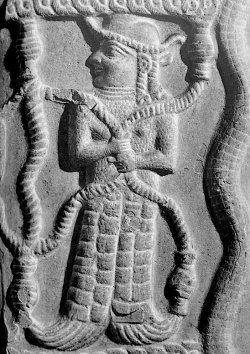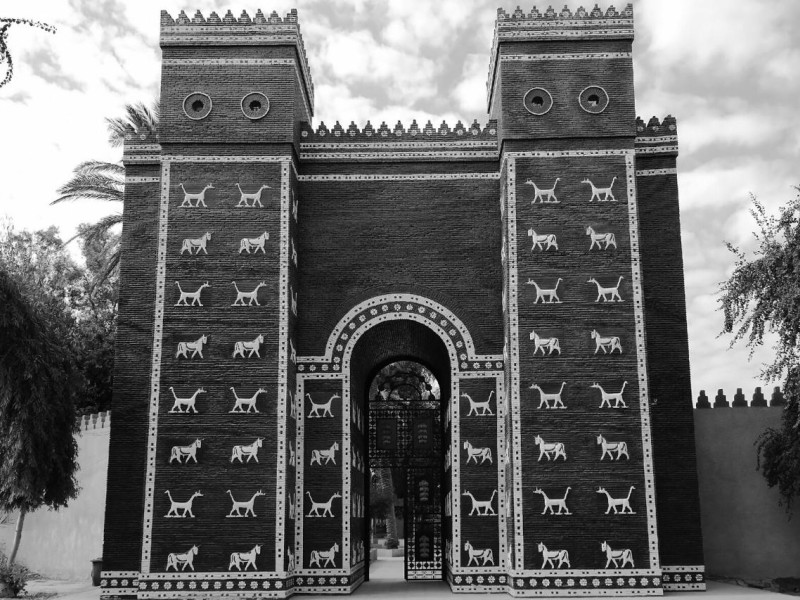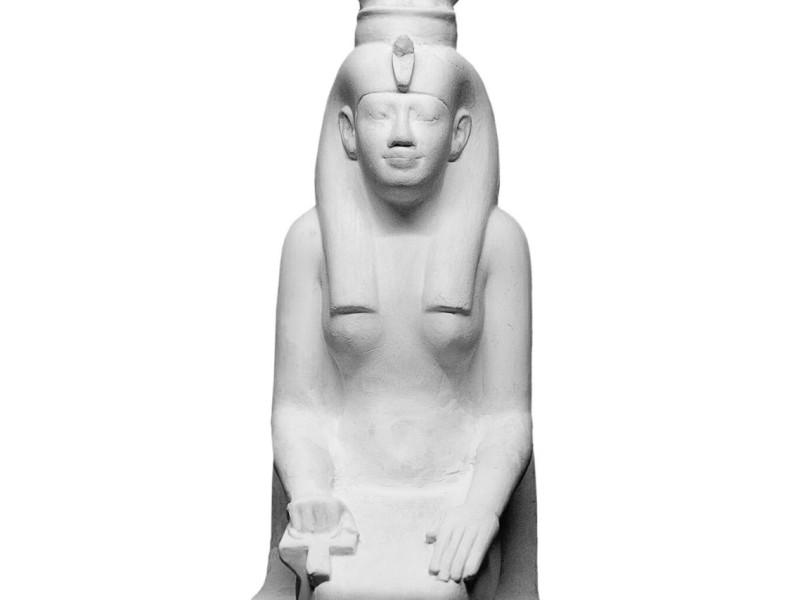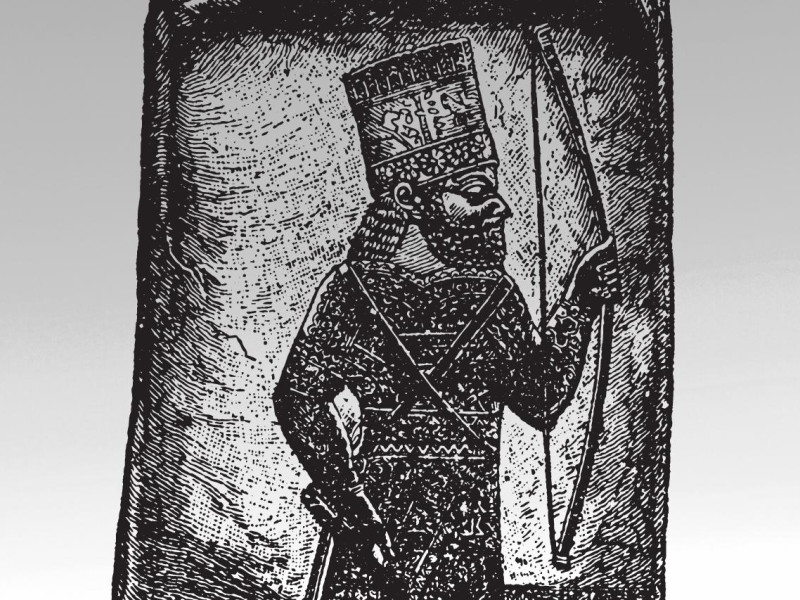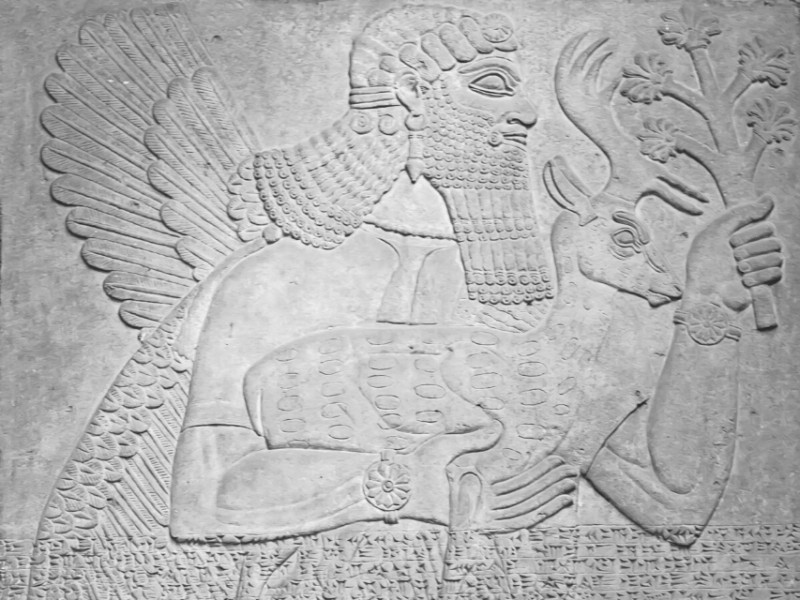Ninhursag: How the Deity of Malgum Became the Mother Goddess of Sumer
Ninhursag was a deity in the ancient Mesopotamian pantheon who began as a city goddess.
Slowly, she rose through the ranks to attain the enviable position of Mesopotamian mother goddess. She was a fertility goddess whose powers brought forth wildlife, especially wild donkeys.
To learn more about how this local deity became popular throughout Mesopotamia, continue reading this article.
Who Is Ninhursag?
Ninhursag is a major Sumerian deity who was part of the Annunaki, the seven Sumerian deities who were in charge of the destinies of humans. They were the offspring of Ki and An. According to Sumerian legend, Ninhursag was the great and true Lady of heaven. In paintings, she was depicted with omega-shaped hair.
She was also known as the nourisher of Kings since the Sumerians believed her milk fed their Kings. She hung cases of a bow on her shoulders and had a tiered skirt. Her temple, located on the hill of Eridu, was called Esalgia. She also had another temple in the city of Kish.
Meaning of Her Name
“Nin,” in the Sumerian language, was the equivalent of the word “lady.” Hursag, on the other hand, was the sacred mountain or hill on which she was worshiped. The mountain on which her temple was located was at Eridu, a city in the south of Mesopotamia. So by combining these words, Ninhursag could be translated to mean “lady of the sacred mountain.”
Other Names and Their Meanings
Ninhursag’s name was initially “Ninmah,” which meant “Magnificent Queen.” However, when her son, Ninurta, made the mountains, he changed her name from Ninmah to Ninhursag. Her other names included Nintu which translated into “Mother of Creation” and Belet-ili which meant “lady of the gods.” In ancient Babylonia, she was referred to as Ninmenah and played a significant role in the crowning of the king.
The Sumerian goddess of fertility was also known as Damgalnuna, reflecting her role as the great wife of the prince. Her name Damkina meant “true wife,” elaborating her role as the wife of Enki, the god of knowledge and creation. For her role in childbirth, she was named Shassuru which meant goddess of the womb. Her name Tabsut-ili meant mother of the gods, depicting her role as the mother of other gods.
Ninhursag was also associated with Ki, the Sumerian goddess of the Earth. Ninmah was once a deity on her own with her own cult and temple of worship, and so was Ninmenna, who was a Babylonian deity. However, they were absorbed by the Ninhursag goddess as years went by and both cultures collided.
The Origins
Before Ninhursag became the mother goddess of Mesopotamia, she was the goddess of fertility in the city of Malgum. There she was named Damalguna and Damkina and her husband was Sul-pa-e, a deity whose domain was the underworld. As the goddess of fertility in Malgum, Ninhursag had three children: Asgi, Lisin and Lil.
Mother Goddess
The worship of Ninhursag became popular and soon she replaced Nammu, who was the Mother Goddess of the land. According to Mesopotamian records, the Sumerians had been worshipping a Mother Goddess figure for centuries, starting from the Ubaid Period. Different female deities became Mother Goddesses over the history of the Sumerians.
To qualify as Mother Goddess, the female deity must be associated with growth, fertility, pregnancy, creation and childbirth. After some time, a different mother goddess replaced or absorbed the old one. Nammu was worshiped as the mother goddess of Sumer from 2600 BC to 2334 BC. Ninhursag’s reign as mother goddess probably started around 2600 BC.
Ninhursag was worshiped as Ki in earlier times. Also known as Kishar, she was the deity responsible for the Earth in Sumerian religion, thus she earned the title Mother Earth. As Kishar, she was believed to form children inside their mothers’ wombs and cater to them once they are born, so a majority of her followers were women who prayed to her to help them care for their children.
Family
According to legend, Ninhursag was the wife of Enki, the god of magic and wisdom. Enki and Ninhursag gave birth to Ninsar, the deity of plants. Enki then had a daughter with Ninsar called Ninkurra, the goddess of pasture. Once again, Enki bore another daughter with Ninkura named Uttu, the goddess of weaving.
Uttu complained that Enki did not love her, so she fled from home. She was advised by her great-grandmother, Ninhursag, to sow Enki’s seed in the soil. This gave rise to the eight plants which were the first plants to ever grow. The eight plants then became the source of eight other gods.
These eight deities were Abu, Nintulla, Ninsitu, Ninkasi, Nanshe, Azimua, Emshag and Ninti. Abu was the god of plants while Nintulla was the deity who oversaw the region of Makan in Sumer. Ninsitu, Ninti and Azimua were the goddesses of healing, Ninkasi was the goddess of beer, and Nanshe was the goddess of magic and wisdom. Enshag was the god of Dilmun, a region in Eastern Arabia.
Symbols and Depictions
Ninhursag used a symbol that was similar to the symbol for the Greek word Omega. She was either depicted in a hairstyle similar to the omega symbol or wore a crown fashioned into the omega symbol.
There were several reasons given for why Ninhursag used the omega sign. According to some scholars, the omega sign represented an inverted womb, reflecting her role as a mother.
Often accompanying the omega sign was a knife. This knife was symbolic of the knife used in cutting off the umbilical cord. Some paintings depict her with wings and a tiered skirt holding a staff that featured the omega symbol. She was accompanied by a lion cub tethered to a leash she held in her hand.
Roles of Ninhursag
The goddess was a creator who brought both humans and gods into existence. She was part of the class of four creator deities of the ancient Sumerian pantheon and was one of the major deities that always appeared in almost every Sumerian myth.
The Great Mother
The Sumerians viewed Ninhursag as the Great Mother who oversaw everything and was responsible for nurturing growth. She was included in the list of the four deities involved in the creation of the universe. As a mother, her main role was the protection of women and children. She also oversaw the process of birth, right from conception to childbirth.
There were figures that depicted her with a child who was sucking on her left breast. Women often prayed to her to help them conceive and to protect them and their babies during pregnancy.
The Creator
She was also famous for creating humans and other gods as we’ve already discovered. She was often portrayed as a co-creator who was responsible for nurturing and growth. She helped create humans, plants and animals. Ninhursag was responsible for forming babies in the wombs of mothers.
The Myth of Ninhursag and Enki
The story of Ninhursag and Enki tells the origins of the world which began in a garden called Dilmun. Dilmun was a paradise garden similar to the Garden of Eden in the Biblical account of creation.
According to the myth, Ninhursag, who had gone out to help in creation, came back in the winter to rest in the garden. There, the young and vibrant Ninhursag encountered the charming god of magic and wisdom, Enki, and they both fell in love.
Ninhursag Gave Birth to Ninsar
After spending some time together, Ninhursag conceived and gave birth to their first daughter, Ninsar. Ninsar then received blessings from Enki, which made her mature into a full woman in only nine days.
Spring came around and Ninhursag went about her creation duties again, leaving Enki and their daughter alone. This made Enki miss his wife, Ninhursag, and he couldn’t wait for her return.
Enki Seduces Ninsar
One day, Enki sighted his daughter walking in the bush and lusted after her. He was under the impression that Ninsar was an incarnation of his beloved wife Ninhursag. He seduces her and Ninsar becomes pregnant after a few days. Soon, Ninsar became pregnant by her father and gave birth to a daughter who they named Ninkurra, the goddess of mountain vegetation.
Enki Falls for Ninkurra
Ninkurra, like her mother, also matured into a full woman in nine days. She was a sight to behold and before long, Enki fell for Ninkurra. He saw his wife’s reflection in the young Ninkurra and seduced her as well. A few nights later, Ninkurra too fell pregnant and she gave birth to a daughter which they named Uttu.
Uttu Becomes Heartbroken
Uttu also matured in nine days and fell for Enki’s seduction. All the while, Enki thought Uttu was his wife, Ninhursag. However, upon realizing that Uttu was not Ninhursag, Enki left her and journeyed to earth to continue his roles. This broke Uttu’s heart, who went to see Ninhursag for help.
Ninhursag Comes to the Aid of Uttu
Ninhursag aided Uttu by advising her to clean Enki’s seed and sow it in the soil at Dilmun. The seed germinated and bore eight different plants that looked appetizing. When he passed by, Enki saw the beautiful plants and asked his vizier, Isimud, to pluck the first plant for him. Ninhursag enjoyed the delicious taste of the first plant and asked for the rest of the plants.
Ninhursag Curses Enki
Enki enjoyed all the plants and this made Ninhursag angry when she returned. So Ninhursag cursed her husband and fled both the garden and the world. Soon after that, Enki fell seriously ill and all attempts to heal him proved futile. As his condition worsened, the other deities resorted to mourning him.
Ninhursag Is Found
The only one who had what it took to heal him was Ninhursag, but no one knew her whereabouts. Fortunately, one of Ninhursag’s animals, a fox, came out of the blue and went to fetch the goddess Ninhursag. When she returned, the deteriorating condition of her husband touched her. She took Enki and put his head on her, asking him where exactly he felt the pain.
How Ninhursag Healed Enki
When Enki told her where he felt pain, Ninhursag drew out the pain from Enki’s body and gave birth to a new deity. They repeated this process until Ninhursag drew all the eight pains from Enki’s body and turned them into eight deities. As already mentioned above, the eight gods that were bore from them were Abu, Nintulla, Ninsitu, Ninkasi, Nanshe, Azimua, Emshag and Ninti.
Ninhursag Forgives Enki
Enki then asks for forgiveness for seducing the girls and eating the plants of Uttu. Ninhursag forgives Enki for his recklessness and lustful desires. The two deities, Enki and Ninhursag, reconciled and went back to their roles as creators. The Sumerians portrayed Ninhursag as a very powerful deity who could cause a major god like Enki to fall sick and heal him.
The Myth of Ninhursag and the Bible
Scholars have drawn some parallels between the myth of Ninhursag and Enki and the creation story of the Bible. According to them, the Biblical creation account may have been inspired by the Sumerian myth. For example, they cite the garden paradise of Dilmun as an inspiration for the garden of Eden. The creation of Eve from the rib of Adam was also believed to be drawn from the creation of the goddess Ninti from Enki’s rib.
One of Enki’s body parts that fell sick was his ribs, and when Ninhursag drew out the pain from there, she created the deity Ninti. The meaning of Ninti is “one who gives life” and the meaning of Eve is also “one who gives life.” So based on these similarities, some people have concluded that the Hebrew writer of Genesis in the Bible may have been inspired by the myth of Ninhursag.
However, there are striking differences between the two accounts of creation. For example, Adam and Eve were neither deities nor were they creator gods like Enki and Ninhursag. Adam did not seduce any of his offspring as Enki did in the Sumerian creation myth. And alhough Adam sinned and required forgiveness, his sin did not make him ill for which he needed healing.
The Myth of Enki and Ninmah
Another story of creation that made the rounds during the Babylonian days was of Enki and Ninmah. We’ve already discussed that one of the names of Ninhursag was Ninmah. In the myth of Enki and Ninmah, Ninhursag gradually lost her status and became an inferior deity to Enki. In the story, the minor gods became tired of toiling day and night because they had to do all kinds of jobs.
These jobs included digging, farming and harvesting. Out of exasperation and exhaustion, these minor gods called out to Enki to come to their aid. However, Enki, who was also resting from all his creative efforts, could not hear their cries. Thus, Nammu, Enki’s mother, heard the cries of the minor gods and woke Enki up.
She then presented the petition of the younger gods to Enki, who decided to grant their request. Enki instructed his mother to create human beings along with Ninmah (Ninhursag) and other fertility goddesses. The humans were to help the gods in carrying out their daily tasks. After the goddesses were done with the creation of humans, Enki hosted a great festival.
The Contest Between Ninhursag and Enki
At the festival, Enki was praised by the gods for his ingenuity in helping relieve them of their daily toils. Ninmah and Enki sat at the same table and got themselves drunk on beer. While they were intoxicated, Ninmah challenged Enki to a competition. The contest was simple: Ninmah would create a being with defects and challenge Enki to improve on the fate of the being.
First, Ninhursag created a man who had lame hands and Enki improved the man’s fate by making him serve the king. In doing so, the man did not have to steal to fend for himself. Next, Ninhursag created a blind man but Enki improved the man’s destiny by making him a musician in the king’s court. This competition goes on for some time, with Enki getting the better of Ninhursag each time.
Then Ninhursag created a being with no sexual organs and challenged Enki to improve on the being’s life. Enki met the challenge by making the man a eunuch in the King’s palace. Ninmah grew frustrated with Enki’s solutions to her challenges, making her throw her clay on the floor. Enki saw this as an opportunity to challenge Ninhursag and picked up the clay.
Enki Challenges Ninhursag
Enki then threw a challenge by asking Ninhursag to improve the fate of any being that he created. First, he created a being and struck the being with afflictions throughout the body. Initially, Ninmah tried feeding the being to no avail. She then tried to make it function in any way possible but all her efforts proved futile.
Tired of trying, Ninhursag then complained bitterly about Enki’s design, claiming the being was neither alive nor dead. She retorted that the challenge was impossible and it was unfair on Enki’s part to put up such a challenge.
Enki then reminded her of all the challenges she gave him which he surmounted without complaining. Scholars don’t know the response Ninhursag gave to Enki because that part of the story is lost.
However, according to the rest of the myth, Enki won the contest and Ninmah accepted defeat. This made Ninmah lose her status as a deity who was equal to Enki. However, her followers still viewed her as a powerful deity they could rely on in difficult times.
Ninhursag in the Atrahasis
According to the famous Akkadian epic, the Atrahasis, Ninhursag was mentioned as the Great Mother who created human beings. Her primary creating material was clay, which she mixed with other parts such as intelligence and blood obtained from a deity.
The Akkadian epic also mentioned Enki’s creation of human beings to aid the minor gods in doing menial work. The myth told the story of the Great Flood unleashed by the god Enlil which destroyed the world. In the Atrahasis, Ninhursag was seen mourning the death of her offspring.
Other Myths
Some ancient myths mentioned Ninhursag as a co-creator and wife to the sky god, Anu. Other myths also associate the deity with the Akkadian god, Kishar. Throughout her history, Ninhursag was always included in the pantheon of major gods.
Temples and Worship
The temples of Ninhursag were widespread in Sumer due to the popularity of her worship. A temple of Ninhursag was located in the city of Adab in ancient Sumeria, while another temple was in the city of Kesh where she earned the name Belet-ili of Kesh. Other major cities that hosted her temple included Mari, Ur, Uruk, Lagash and Ashur.
There were no weekly activities that marked the worship of the deity. However, there were annual festivals that celebrated the goddess. Her devotees mostly worshiped her privately in the comfort of their homes and only adored her publicly during festivals. By the second millennium BCE, the worship of female deities began to decline and so did the worship of Ninhursag.
Male deities began taking the center stage in Mesopotamian religion. Deities like Ashur became more popular and powerful than female goddesses such as Innana and Ereshkigal. Hitherto, these goddesses were widely regarded as powerful female deities. By 612 BCE, the worship of Ninhursag had died down.
Summary
Throughout this article, we’ve looked at the origins, worship, family and mythologies of Ninhursag. Here is a recap of what we’ve read so far:
Ninhursag was a goddess of fertility who began as a city goddess and became the Mother Goddess of the Mesopotamian religion.
She was known as a creator god alongside her husband, Enki, with whom she had children.
She was depicted as a woman with either an omega-shaped hairstyle or crown and holding a lion cub at the end of a leash.
In the story of Ninhursag, the deity healed Enki after he had eaten eight plants and gotten sick.
Sumerian mothers believed that Ninhursag formed their babies in their wombs and aided in childbirth.
The temples of Ninhursag were widespread in major Sumerian cities as her worship became popular.
By the second millennium, Ninhursag’s worship had begun to decline, and by 612 BCE she was no longer worshiped.
Ninhursag was one of the most powerful deities to ever have been worshiped. Her legacy was felt for thousands of years as she was often associated with other goddesses such as Hathor and Gaia.

